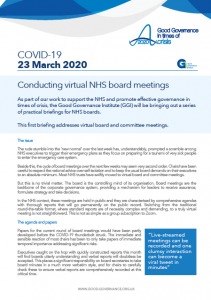Conducting virtual NHS board meetings
23 March 2020

As part of our work to support the NHS and promote effective governance in times of crisis, the Good Governance Institute (GGI) will be bringing out a series of practical briefings for NHS boards.
This first briefing addresses virtual board and committee meetings.
The issue
The rude stumble into the ‘new normal’ over the last week has, understandably, prompted a scramble among NHS executives to trigger their emergency plans as they focus on preparing for a tsunami of very sick people to enter the emergency care system.
Beside this, the cycle of board meetings over the next few weeks may seem very second order. Chairs have been careful to respect the national advice over self-isolation and to keep the usual board demands on their executives to an absolute minimum. Most NHS trusts have swiftly moved to virtual board and committee meetings.
But this is no trivial matter. The board is the controlling mind of its organisation. Board meetings are the backbone of the corporate governance system, providing a mechanism for leaders to receive assurance, formulate strategy and take decisions.
In the NHS context, these meetings are held in public and they are characterised by comprehensive agendas with thorough reports that will go permanently on the public record. Switching from the traditional round-the-table format, where standard reports are of necessity complex and demanding, to a truly virtual meeting is not straightforward. This is not as simple as a group subscription to Zoom.
The agenda and papers
Papers for the current round of board meetings would have been partly developed before the COVID-19 thunderbolt struck. The immediate and sensible reaction of most chairs has been to only take papers of immediate temporal importance addressing significant risks.
Executives caught on the hop with quickly constructed reports this month will find boards utterly understanding and verbal reports will doubtless be accepted. This places a significant responsibility on board secretaries to take board minutes in a much more verbatim style, and for chairs to carefully check these to ensure verbal reports are comprehensively recorded at this critical time.
This is where boards with sound board assurance frameworks (BAFs) that properly represent the significant risks will be at an advantage, since they will be better placed to ensure that essential information is captured at a time when so many important issues are being addressed.
GGI will be producing further advice on board agendas in the next few days.
Meeting in public
By law, NHS boards must meet in public.
This week, some board meetings are planned as a core of board members meeting in the usual way with the public able to attend, but asked not to for public health reasons. Other board members are being asked to call in by phone or use systems such as Monday.com, GoTo or (GGI’s favourite) Zoom. This complies with the letter of the law, but it’s clumsy.
Some boards are meeting fully-virtually and just not bothering in this emergency week with the ‘in public’ aspect. Some plan to stream their fully virtual meetings.
GGI’s advice is that this approach is fraught with problems and creates potential for all sorts of mischief. Live-streamed meetings can be recorded and one clumsy interaction can become a viral tweet in minutes.
We would recommend that NHS England suspend the requirement for meetings to be held in public and that instead boards invite key stakeholders to represent the public, using the available technology to join meetings as observers.
As an alternative, members of the public could request virtual access to watch board meetings, but we would recommend that any such observers are required to abide by a meeting etiquette agreeing not to record proceedings. This follows the accepted practice of physical board meetings, where chairs would not accept observers recording discussions on their phones.
We will separately publish a model board etiquette for virtual NHS board and committee meetings for both board members and observers.
The art of the virtual meeting
Switching to chairing and participating in a virtual board meeting will feel clunky to begin with. We recommend using the software the evening before the first attempt.
GGI has found virtual meetings software intuitive and quick to master but board secretaries should ensure that all board members get the opportunity for a quick tutorial and then a dry run before the actual meeting.
Board members can help by emailing the chair in advance with questions or points they wish to raise, although meeting software does offer ways to alert the chair that a participant wishes to speak. Chat facilities can also be useful.
Call to action
GGI will be tracking how boards are managing virtual meetings and sharing experiences. We would like to hear how your first full virtual board meeting goes. Please email your experiences and any hints and tips to GITOC@good-governance.org.uk

